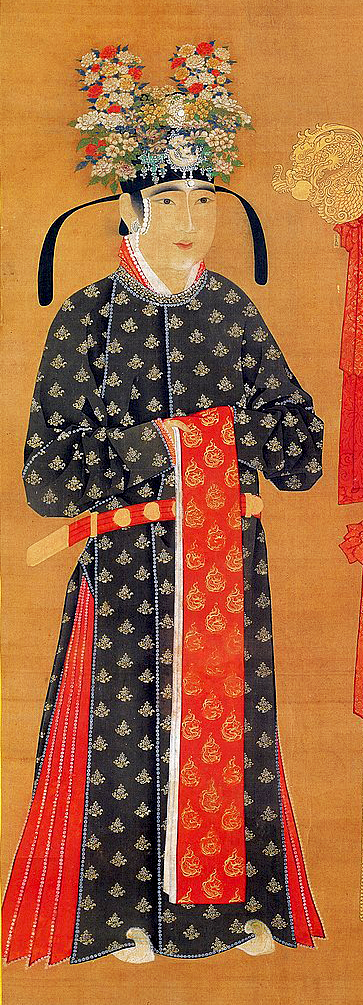Song Dynasty Attendant and Empress: 宋后仆从
Model: 清音音音音
Music: Music describing plum blossom
During the conservative Song dynasty, women's clothing, especially that of noble and imperial women became very ostentatious. Often the elite women were heavily made up and their hairs were adorned with heavy and elaborate jewelry. The crowns they wore were very elaborate, with many of them often depicting dazzling carvings of immortals, dragons, and spectral clouds.
ICONIC SONG DYNASTY ATTENDANTS
A Song Empress' attendant, their faces are slightly made up, with a noticeable white highlight over the nose ridge and light areas of make up over their forehead and chin. A decorative gem is stuck upon their made up forehead. They wear an elaborately embroidered dark Yuanlingfu or round collar robe. They wear the hats of an official- however, most prominently, the hat is decorated with a veritable banzai meadow of silk embroidered flowers of many colors and streaming pearls. Attendants and entertainers with elaborate headpieces that resembled that of late- Tang designs were depicted in Song, Liao, and Western Xia artworks long after the fall of the Tang dynasty.
Conservative and Vibrant: the Song dynasty- in contrast with the very open and tolerant Tang that preceded it, was by contrast more inwardly focused. The Song marked a returning of sort to traditional Chinese culture and a reembrace of some fundamental pillars of Chinese ways such as Confucianism and rigorous scholarship. During this period, scholars dominated the court. Although militarily they were never as dominant as that of the Tang or some of the other powerful Chinese dynasties, in terms of technological innovations and a respectable standard of living and education it was world class at its time. It was a golden age in its own right.
A 12th century Hua Yi Tu map covers China during the Song Dynasty. The map depicts mountains, rivers, lakes, as well as more than 400 administrative place names of China. It includes Korea to the east, the north of the Great Wall, northeast of Heilongjiang region, to the south of Hainan Island. Compared to the dominant Tang dynasty that preceded it, the Song never managed to become the sole hegemon of East Asia, its entire existence was locked in a mortal struggle against the steppe invaders from the north, first the Khitan Liao dynasty, then the Jurchen Jin dynasty, and finally the Mongols that one day would displace the Song and establish the Yuan dynasty.
ELABORATE SONG DYNASTY COURTLY ATTIRES
A Song dynasty Empress in 翟衣 ceremonial attire called "Di Yi." These ostentatious robes were worn during state and ancestral ceremonies, as well as during seating for the imperial portraits.
The imperial dress of Empress Xiang of Song dynasty. She acted as regent to the Song and presided the court before the accession of Emperor Huizong of Song. Huizong's ruinous tenure eventually led to the 1127 disaster at Kaifeng where the Song imperial family were abducted by the Jurchen conquerors of the Jin dynasty (Jingkang Incident)
Wreathed in symbols: the Song empress's "Di Yi" or imperial robes 翟衣 are interwoven with pairs of birds, which symbolizes marital felicity and devotion. Flying dragons ran across the hems of her sleeves. Bright plum flowers also dots the blue fields of her dress.
Closeup of the Song dynasty empress' attire that prominently displays the dizzying designs on her crown- which combines a procession of immortals and saints, floating apsaras (Buddhist angels) floating clouds of flowers all amalgamating into a fierce golden dragon.
Empress Wu (Song dynasty)- Empress Xiansheng. She was the wife of Emperor Gaozong of the Song Dynasty. Gaozong was remarkable in being the 1st emperor of the Southern Song. His ancestors and distant relatives were defeated and captured by the nomadic Jurchens when the Song imperial capital of Kaifeng was sacked in 1127 (Jingkang Incident.) Gaozong was able to barely escape capture and re-found the Song dynasty in the south. Note the same persistent designs in her attire, also the elaborate designs on her crown.
Another portrait of a Song dynasty empress that prominently displays the dizzying
designs on her crown- which combines a procession of immortals and saints,
floating apsaras (Buddhist angels) floating clouds of flowers all amalgamating
into a fierce prismatic dragon.
Seated portrait of Emperor Renzong's Empress flanked by 2 attendants.
MORE EMPRESS AND ATTENDANT GALLERY
Thank you to my Patrons who has contributed $10 and above: You made this happen!
➢ ☯ MK Celahir
➢ ☯ Muramasa
➢ ☯ Thomas Vieira
➢ ☯ Kevin
➢ ☯ Vincent Ho (FerrumFlos1st)
➢ ☯ BurenErdene Altankhuyag
➢ ☯ Stephen D Rynerson
➢ ☯ Michael Lam
➢ ☯ Peter Hellman
➢ ☯ SunB






























Comments
It seems the Song could be colorful, grandiose and ostentatious as well with their fashions.
Taizu of Jinn 金太祖,王旻 come from Goryeo.
Taizu of Goryeo 高丽太祖,王建 come from Jianghuai China.